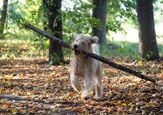Study Shares Quick Trick to Getting Your Dog's Attention

Researchers found the sweet spot that captures your dogs attention and gains the results you're looking for.
It’s a common challenge. Dog owners trying to capture and hold their dog’s undivided attention for more than a nanosecond. We’re not talking about disciplines such as obeying the five basics (sit, stay, heel, down, and leave it) where training and your dog’s safety may be involved. We’re talking about everyday stuff. Like directing him over to that errant treat he missed scooping up yesterday. Or, having him come over and sit beside you while you’re binge-watching your favorite series. The easy ask that often requires two, three, or four, repeats before you get his attention and more importantly, a response.
Now, if you think it’s just your dog who’s slow on the uptick when it comes to cuing in to the message you’re sending, you’d be wrong. In fact, studies have been done on this and more specifically, on what causes a dog to naturally choose to receive and respond to the message you’re trying to send.
Researchers from Germany’s Max-Planck-Institute for Evolutionary Anthropology took on this somewhat whimsical task and determined the secret to effectively communicating with your pooch is something called referential communication. In humans, it’s how babies learn to speak and it was a process identified by the University of Cambridge as they discovered that infants learn language through the rise and fall of the speaking tone. Think of the rhythm of nursery rhymes or songs.
Back to our dogs. Similar to infants, dogs are known to be highly responsive to baby talk. So, we know they process language in the same way as infants. And just like human babies, by saying a word and pointing to that item, we help them make the correlation.
In the study, five different approaches were taken to determine which worked best at gaining attention and an appropriate reaction that included going over to and picking up the item. They included:
- pointing at an item
- pointing and gazing at an item
- gazing at an item
- pretending to throw an item
- control condition
20 dogs were outfitted with eye-tracking headgear to record their eye movements. Partnered with their owners, their gaze and subsequent behaviors were then tracked.
What the researchers found was that when the owner pointed to an item, the dog’s focus was on the owner’s hand, not the item. Similarly, if the owner pretended to throw the item, the dog’s gaze was temporarily directed toward where they thought the item may land, although not for long. But, in the same way that infants learn, combining both pointing and a visual or verbal cue is how the dog immediately clued in and went over to pick the item up.
According to those involved in the study, the results were significantly above chance levels.
This suggests the next time you want your dog to cuddle up next to you, call his name in your favorite baby voice, then point and look at your lap.
Easy peasy.

Sharing space with three seriously judgy Schnoodles and 2 felines who prefers to be left alone. #LivingMyBestLife
More by Mary Simpson






















